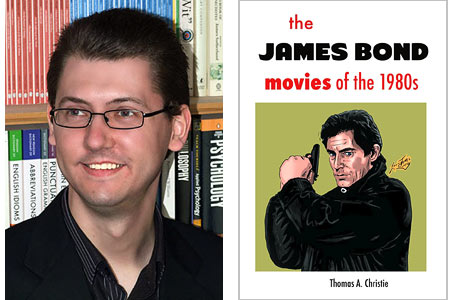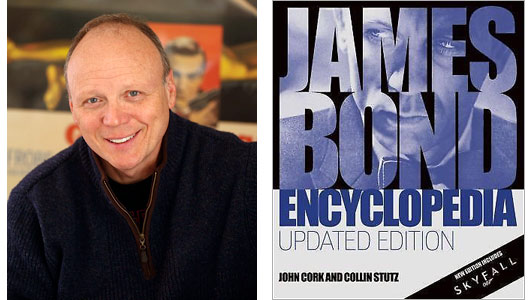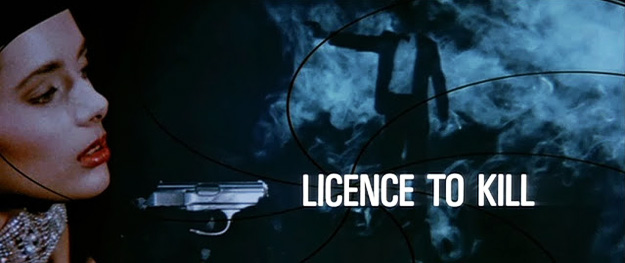“With his wealth of dramatic stage experience, Timothy Dalton seemed ideally suited to this harsher take on Bond, bringing both depth and sensitivity to the character while creditably articulating his quiet rage and single-mindedness. This was Bond, but not as we knew him — now much closer to the tone, if not the setting, of the original Fleming texts.” — Thomas A. Christie, author of The James Bond Movies of the 1980s
The Digital Bits and History, Legacy & Showmanship are pleased to present this retrospective commemorating the 30th anniversary of the release of Licence to Kill, the 16th (official) cinematic James Bond adventure and second (and final) entry to feature Timothy Dalton as Agent 007.
Our previous celebratory 007 articles include Moonraker, Quantum of Solace, From Russia with Love, Never Say Never Again, Live and Let Die, Octopussy, Casino Royale (1967), Tomorrow Never Dies, Die Another Day, Dr. No, The Living Daylights, The Spy Who Loved Me, You Only Live Twice, Diamonds Are Forever, Casino Royale, For Your Eyes Only, Thunderball, GoldenEye, A View to a Kill, On Her Majesty’s Secret Service, Goldfinger, and 007… Fifty Years Strong.
The Bits continues the series with this retrospective featuring a Q&A with an esteemed group of film historians and James Bond authorities who discuss the virtues, shortcomings and legacy of 1989’s Licence to Kill. [Read on here...]
The participants for this segment are (in alphabetical order)….
Thomas A. Christie is the author of The James Bond Movies of the 1980s (Crescent Moon, 2013). He has written numerous other books, among them A Righteously Awesome Eighties Christmas (Extremis, 2016), Mel Brooks: Genius and Loving It! (Crescent Moon, 2015), Ferris Bueller’s Day Off: Pocket Movie Guide (Crescent Moon, 2010), John Hughes and Eighties Cinema: Teenage Hopes and American Dreams (Crescent Moon, 2009), and The Cinema of Richard Linklater (Crescent Moon, 2008). He is a member of The Royal Society of Literature, The Society of Authors and The Federation of Writers Scotland.
John Cork is the author (with Collin Stutz) of James Bond Encyclopedia (DK, 2007) and (with Bruce Scivally) James Bond: The Legacy (Abrams, 2002) and (with Maryam d’Abo) Bond Girls Are Forever: The Women of James Bond (Abrams, 2003). He is the president of Cloverland, a multi-media production company. Cork also wrote the screenplay to The Long Walk Home (1990), starring Whoopi Goldberg and Sissy Spacek. He wrote and directed the feature documentary You Belong to Me: Sex, Race and Murder on the Suwannee River for producers Jude Hagin and Hillary Saltzman (daughter of original Bond producer, Harry Saltzman). He contributed new introductions for the original Bond novels Casino Royale, Live and Let Die, and Goldfinger for new editions published in the UK by Vintage Classics in 2017.
Andrew McNess is the author of James Bond in our Sights: A Close Look at “A View to a Kill” (Xlibris, 2011; and updated in 2015). Based in Melbourne, Australia, Andrew works for a not-for-profit organization that supports bereaved families. He has published scholarly work in subject areas such as youth bereavement, peer support and health promotion. He greatly enjoys combining his writing interests with a lifelong interest in film, and continues to do so via Slivers of Cinema (sliversofcinema.blogspot.com) and a site of Bond-related commentary, A View on Bond (www.aviewonbond.net).
The interviews were conducted separately and have been edited into a “roundtable” conversation format.
And now that the participants have been introduced, might I suggest preparing a martini (shaken, not stirred, of course) and cueing up the soundtrack album to Licence to Kill, and then enjoy the conversation with this group of James Bond authorities.
Michael Coate (The Digital Bits): In what way is Licence to Kill worthy of celebration on its 30th anniversary?
Thomas A. Christie: Licence to Kill marked an end of an era in many ways. It would be the final James Bond movie to feature Timothy Dalton in the lead role, the last time that John Glen would occupy the Bond director’s chair, and of course it would also be the series’ Cold War-era swan song. Though the USSR was not to feature in the film (barring the odd throwaway line), when the series returned to prominence in the mid-1990s the world would be a very different place — the Berlin Wall had been demolished, the Soviet Union would collapse shortly afterwards, and the US would be a unipolar superpower. In terms of film history, Licence to Kill is a fascinating curio. Bond was far from an invincible, wisecracking superspy here, instead becoming the epitome of cold fury who was being driven by revenge. With his wealth of dramatic stage experience, Dalton seemed ideally suited to this harsher take on Bond, bringing both depth and sensitivity to the character while creditably articulating his quiet rage and single-mindedness. This was Bond, but not as we knew him — now much closer to the tone, if not the setting, of the original Fleming texts. At this stage in world history, geopolitics were going through significant turbulence, and Licence to Kill was the response of the Bond creative team to an increasingly precarious global environment. Looking back, it is fascinating to see just how far they were willing to depart from the series’ recognized formula in order to embrace not only a world where old international certainties were fast eroding, but an increasingly slick and rapidly-changing cinematic landscape where the boom in action movies throughout the 1980s had abruptly left the Bond cycle looking rather quaint and out-of-touch by comparison.
John Cork: Licence to Kill is James Bond’s crucible. It was the film that destroyed Bond and started the path to transform 007 into the modern, well-drawn character we know today.
The film asked, what happens if we strip 007 bare? What if we take away his licence to kill? But somehow the filmmakers went further, inspired by Timothy Dalton’s purist approach and serious take on the character. They seemed to ask: what if we take away his aplomb? His coolness under pressure? His wit? His elegance? His unerring judgment? What if we took away the grand scale of his adventures, the sweeping sense of majesty, the midlife-crisis cars, the élan with which Bond approaches his work, the consequence-free sex, the smoldering sensuality, the aspirational branding, the top-tier production budget? What if we took away virtually everything that separates 007 from a generic 80s action hero? The answer was that Bond lost his audience.
Licence to Kill placed 36th in U.S. box office in 1989, behind Fletch Lives, Karate Kid III, Star Trek V, Ghostbusters II, Lethal Weapon II, Back to the Future II, and Indiana Jones and the Last Crusade. In short, it was near the bottom of the franchise film food chain, only under-grossed by cheap horror film fare like Nightmare on Elm Street 5, The Fly II, and Friday the 13th Part VIII. The film’s devoted fans blame the marketing campaign, tough summer competition, budget constraints, and everything except the film itself, but (to paraphrase Shakespeare) “the fault is not in our stars, but in the hands of our intellectual property rights holders.” The film is charmless, concocted during a time of falling 007 box office revenues, studio cutbacks at MGM, and a search for direction among the Bond creative team.
But there is much to celebrate. It is the film that finally killed the Roger Moore-era humor that Roger himself lost the ability to control after The Spy Who Loved Me. It is a film with spectacular action, a couple of great performances, and a fascinating Yojimbo-inspired script. Yet the loss of humor was not replaced with real emotional weight to most of the scenes. Since viewers had never had a consistent Felix Leiter, Bond’s friendship with him and passion for revenge was diminished. The script, outlined by Maibaum and Wilson, was largely written by Wilson because of the Writers Guild strike of 1988. As clever as many aspect were, the film had too many characters, a complex plot that involved a televangelist setting the price of cocaine in the United States while leading a religious cult, and Bond’s anger resulting in the unforgivable deaths of British agents.
Ultimately, it is the film that proved that James Bond is indestructible. If the character could survive Licence to Kill, he could survive anything.
Andrew McNess: It was the series’ first notably dark excursion, coupled with a lead actor showing significantly more intent to brood than charm; in essence, to take the Bond character somewhere closer to his literary origins. What stands out to me as especially worthy of celebration, though, is the moody — and beautifully sustained — dynamic between Dalton’s Bond and Robert Davi’s Franz Sanchez, and the sense of Licence to Kill almost being an “anti-revenge” action thriller. Bond’s efficacy is contingent on him recognizing that he must extend his mission to a greater good than merely one of revenge. I like the title Licence to Kill because the film, within its escapist trappings, explores what makes one an effective — as opposed to destructive — holder of said licence.
Coate: What do you remember about the first time you saw Licence to Kill?
Christie: The first thing to occur to me when I first saw Licence to Kill was how dark and uncompromising it felt in comparison to the films that had preceded it, even including The Living Daylights. While John Glen’s artistic intention to return the series to its gritty, Cold War roots has been well documented, suddenly we were faced with a Bond movie that seemed to owe more to the likes of Lethal Weapon and Die Hard than it did to the postwar geopolitics of Ian Fleming’s novels. If Roger Moore’s one-liners and safari suits had taken the Bond cycle to one extreme, we were now at its polar opposite — Timothy Dalton’s take on the character was hard-headed, relentless, and perfectly epitomized Bond’s forebodingly obsessive qualities. Audiences were faced with a Bond who was abruptly suspended from his intelligence duties, whose inner torment and desire for vengeance had made him unpredictable, possibly even unstable, and which took the narrative in a markedly different direction from the expected norm. This surprisingly stark shift in tone may have signaled a jarring break from what many viewers might have anticipated from a Bond film, but it definitely shook things up and made the storyline considerably more interesting as a result. There was also an undeniable sense of contemporary relevance to proceedings, determinedly moving the focus from the flagging East-West espionage plotlines of earlier eighties entries in the series and instead centering on issues such as the international drugs trade and organized crime cartels.
Cork: I wrote a feature film (The Long Walk Home) that was being shot in Montgomery, Alabama, where I grew up, during the summer of 1989. I went to see Licence to Kill on opening night at the late show after a long production day. I had not seen a Bond film for the first time in my hometown since The Man with the Golden Gun. A year earlier I had visited the set in Key West and had high hopes, as always, for the film. But my mind was deeply distracted when I saw Licence to Kill. The film I had written was facing its own struggles, and I was pouring my heart and soul into making sure nothing was overlooked on that end. It was hard for me to just sit back and escape into Licence to Kill. That has not changed over the last 30 years.
McNess: I saw the film at the then-Cinema Center in Melbourne, Australia. An overriding memory is of audience members nearby, in particular a father with his young daughter and son. The thought crossed my mind: “Uh-oh. He thinks he’s bringing them along to a spy romp.” And in due course, the children twisted and turned at the passages of sadism. The father was a busy man, regularly comforting and placating.... I also remember feeling there was a film missing between this and the comparatively sunnier, romantic The Living Daylights, a film that would have brought us more gradually towards the darker, more brutal and cynical world of Licence to Kill. In a way, 1985’s A View to a Kill would have been the more appropriate ’bridging’ film, given the sadism exhibited by the Christopher Walken character. I felt that Licence to Kill had crossed a line in dark qualities. I certainly wondered if the Bond team were asking too much of their loyal audience. That said, I was totally engrossed by the film. It quickly became a favorite.
Coate: In what way was Robert Davi’s Franz Sanchez a memorable villain?
Christie: Licence to Kill is a film which is not sold short when it comes to antagonists. Jockeying for screen time are Anthony Zerbe as the calculating researcher/henchman Milton Krest, Anthony Starke as the scheming financial advisor Truman-Lodge, Everett McGill’s treacherous DEA official Ed Killifer, and Benicio del Toro as volatile bodyguard Dario. Yet as Franz Sanchez, Robert Davi’s performance easily overshadows all of the competition in the villainy stakes. Davi’s performance was impeccably matched to Dalton’s hard-edged Bond; this drug lord was not only economically powerful and professionally influential, but someone whose every word and action seemed to contain an undercurrent of potential menace. Far from the larger-than-life Bond villain of years past, Sanchez always seemed to carry a realistic air of threat, and — by emphasizing the overarching importance that the character places on loyalty above all else — Michael G. Wilson and Richard Maibaum’s screenplay ratchets up the tension by underscoring the increasing peril of Bond’s strategy of appearing to become one of the kingpin’s confidantes, growing close to him before eventually enacting his long-gestating betrayal/vendetta. Davi famously threw everything but the kitchen sink into the role, researching Ian Fleming’s novels and the dynamics of South American drug cartels with great care. Employing a very respectable Colombian accent and sporting an intimidatingly well-built physique, his method acting approach paid dividends by bringing a tangible sense of danger to Sanchez whenever the character is present.
Cork: Robert Davi as Sanchez ranks as one of my favorite Bond villains. He plays the part with a smoothness and sense of menace that I just love. You can tell there is something vile inside of him, but also something very insecure. He’s the one Bond villain where you get the sense that it is indeed lonely at the top. He plays his mistrust without any of the feverish paranoia of lesser actors, but with cold resolve. He also has some great lines: “What did he promise you? His heart? Give her his heart.” And my favorite, “Remember, you are only president…for life.”
Davi manages to rise above the Univision TV movie look of the film, as does Benicio del Toro, who is also one of my favorite Bond henchmen. He brings so much to the film in a modest part, and truly gives viewers the heebee jeebees with his lecherous desire for vivisecting humans.
I also enjoyed Anthony Starke as the yuppie Regan-era MBA capitalist.
Unfortunately, the film was populated with oodles of other lieutenants: Milton Krest, Professor Joe Butcher, Killifer, Pres. Lopez, Heller, and all of them added very little to the proceedings.
McNess: Davi brings a nice sense of poise and dash to Sanchez. When Sanchez quips with the businessmen, the overall effect of this transports me back to a jollier model of Bond film. In these moments and others, Davi brings a sense of fun to proceedings that Dalton’s fuming Bond ultimately cannot. In totality, of course, Sanchez is a reprehensible figure, and Davi delivers many an unsettling moment. However, as Bond actively — and very coolly — goes about creating distrust in Sanchez’s mind, it is difficult not to feel a sliver of sympathy for Davi’s devil. When Sanchez’s empire is literally crumbling around him, there’s a psychological dimension to the fevered proceedings. It’s a different proposition to simply watching a super-villain fume at the destruction of his warped ambitions. When Sanchez finally breaks into a shouting rage, I find the moment oddly cathartic. He may be despicable, yes, but he is also the manipulated man of the piece.









